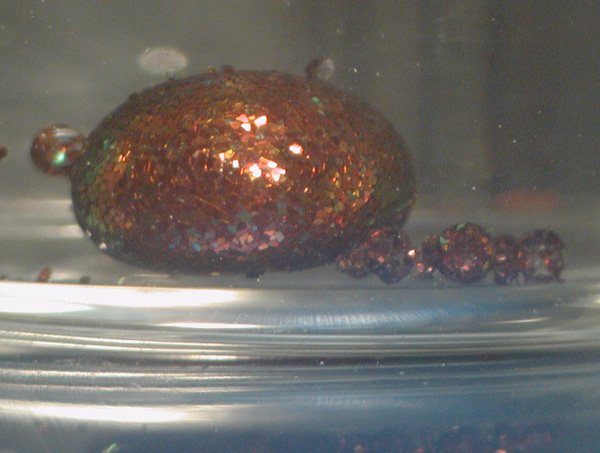Smartdust is a hypothetical wireless network of tiny microelectromechanical sensors (MEMS), robots, or devices, that can detect (for example) light, temperature, or vibration.
The devices, or motes, will eventually be the size of a grain of sand, or even a dust particle, with each mote having self-contained sensing, computation, communication and power.

Link:
When clustered together, these motes automatically create highly flexible, low-power networks with applications ranging from climate control systems to entertainment devices that interact with information appliances.
The smartdust concept was introduced by Kristofer S. J. Pister (University of California) in 2001, though the same ideas existed in science fiction before then (The Invincible, 1964). A recent review discusses various techniques to take smartdust in sensor networks beyond millimeter dimensions to the micrometre level.
Some attribute the concepts behind smart dust to a project at PARC called Smart Matter.
Smartdust devices will be based on sub-voltage and deep-sub-voltage nanoelectronics and include the micro power sources with all solid state impulse supercapacitors (nanoionic supercapacitors).
The recent development of nanoradios may be employed in the implementation of smartdust as a usable technology.
A typical application scenario is scattering a hundred of these sensors around a building or around a hospital to monitor temperature or humidity, track patient movements, or inform of disasters, such as earthquakes. In the military, they can perform as a remote sensor chip to track enemy movements, detect poisonous gas or radioactivity. The ease and low cost of such applications have raised privacy concerns. The possibility that a 'swarm' designed to self-replicate and evolve to solve a problem might progress beyond our control has also raised safety concerns in science fiction stories, such as Prey by Michael Crichton. See also self-replicating machines in fiction. This possibility comprises an end of the world scenario known as grey goo.
The devices, or motes, will eventually be the size of a grain of sand, or even a dust particle, with each mote having self-contained sensing, computation, communication and power.

Link:
When clustered together, these motes automatically create highly flexible, low-power networks with applications ranging from climate control systems to entertainment devices that interact with information appliances.
The smartdust concept was introduced by Kristofer S. J. Pister (University of California) in 2001, though the same ideas existed in science fiction before then (The Invincible, 1964). A recent review discusses various techniques to take smartdust in sensor networks beyond millimeter dimensions to the micrometre level.
Some attribute the concepts behind smart dust to a project at PARC called Smart Matter.
Smartdust devices will be based on sub-voltage and deep-sub-voltage nanoelectronics and include the micro power sources with all solid state impulse supercapacitors (nanoionic supercapacitors).
The recent development of nanoradios may be employed in the implementation of smartdust as a usable technology.
A typical application scenario is scattering a hundred of these sensors around a building or around a hospital to monitor temperature or humidity, track patient movements, or inform of disasters, such as earthquakes. In the military, they can perform as a remote sensor chip to track enemy movements, detect poisonous gas or radioactivity. The ease and low cost of such applications have raised privacy concerns. The possibility that a 'swarm' designed to self-replicate and evolve to solve a problem might progress beyond our control has also raised safety concerns in science fiction stories, such as Prey by Michael Crichton. See also self-replicating machines in fiction. This possibility comprises an end of the world scenario known as grey goo.
Read more: Smartdust
Red Ice Radio
Sofia Smallstorm - Chemtrails, Nanotechnology & The Artificial Environment
Kevin Warwick - Artificial Intelligence & The Rise of the Machines in 2020
Related
- Is Morgellon's Disease real, or imagined?
- Smart Dust & The New Matrix
- "Smart Dust" may soon be watching you
- Chemtrails - Predictions
- Orwellian Ubiquitous Computing May Build Ultimate Surveillance Society (Video)
- Team develops DNA switch to interface living organisms with computers
- Psychic computer that can read people's minds developed
Source: http://www.redicecreations.com
Sem comentários:
Enviar um comentário